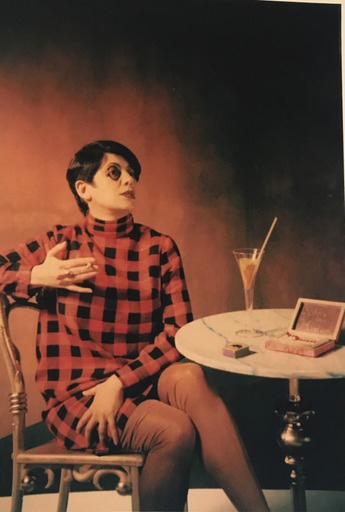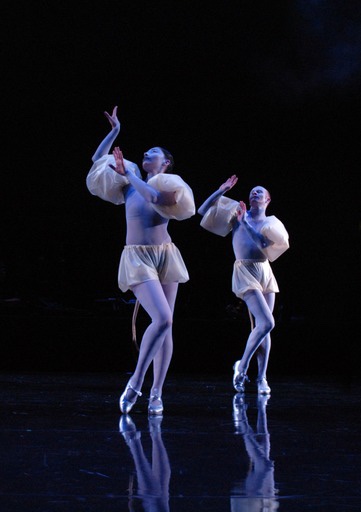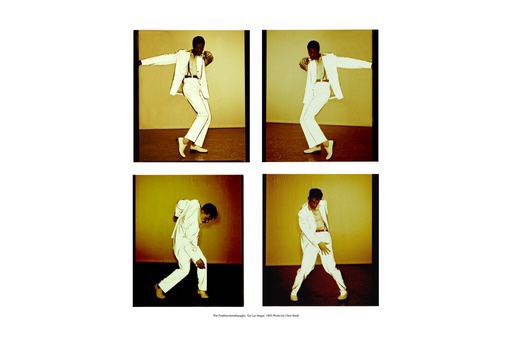Words by Jo Leask.
Choreographer, filmmaker and artistic director Lea Anderson is soon to celebrate the 40th anniversary of her signature all-female company The Cholmondeleys, co-founded in 1984 with Gaynor Coward and Teresa Barker. As well as founding The Featherstonehaughs in 1988, Anderson’s career includes the creation of over 100 works and extensive collaborations with designers, musicians, artists and filmmakers. Her work designed for all kinds of spaces has been performed in clubs, art schools, pubs, galleries, outdoors; digitally, for film, and more recently as performed exhibitions and living archives.
When approached by DanceWest to make a piece for their Festival in May at the Lyric Hammersmith, Lea thought it would be fitting to reconstruct one of her favourite early works, Baby, Baby, Baby, made in 1986. I spoke to an upbeat and reflective Lea on zoom, from her home in North Devon, about the Dance West commission and her dazzling career.
The commission for Dance West – “A new look at old stuff”
Anderson explains that the opportunity from DanceWest was a chance to think about something that happened a long time ago and what it might look like. While thinking about reconstructing the trio Baby, Baby, Baby, originally performed by Coward, Barker and herself, Lea was digging material out of the archive, most of it pre-digital, when she connected with Coward again. She then invited independent dance artist Belinda Neave to join them in reconstructing the work. They set about creating a mixture of old and new, an old work framed in a contemporary context. She talks with fondness about the early cabaret works to which Baby, Baby, Baby belonged that were originally made for music gigs and performed in rowdy pubs or cramped clubs. The dancers would have to stand “just in front of a drum kit and move on the spot, as the floor around was covered with people and spilt beer”. In the early days of the company, no one expected them to make dance so they supported bands and did stand-up comedy, taking every opportunity that came along.
The new expanded version called Baby, is designed for the kind of venues The Cholmondeleys used to work in. While the work premieres at the Lyric Hammersmith, a proper theatre with red curtains which fills Lea with delight, its next venue is a café in Hull. Although Lea and dancers are performing without a band and using playback this time, they’re working with long-term collaborators Steve Blake, who has composed the music and Simon Vincenzi who has designed brand-new costumes.
When I ask about the rehearsal process, Lea tells me she has only rehearsed with the others a few times on zoom and a couple of times in-person in London, which was all good fun. When talking about remembering choreography from years ago, Lea mentions the importance of muscle memory and movement that is retained in the body. With Baby, she was surprised about how much she was able to recall from the original trio. Trying to teach Baby’s idiosyncratic choreography on zoom was a challenge due to the complications about mirroring the right and left side of the body. Lea adds calmly that Baby won’t fall into place until they’re teching at the Lyric Hammersmith, as the work develops in response to its venue.

Returning to the stage
Lea who is in her sixties says that she’s been thinking about the issue of women performing dance over a certain age for some time and how you don’t see many, whereas men don’t seem to stop. (I point out that this might be changing given the recent reappearances of formidable mature dance artists such as Emilyn Claid, Siobhan Davies and Liz Aggiss). When I ask what it’s like to return to the stage again Lea replies that she feels as if she’s never really left it. For someone who is always getting out and making work in the studio, performing live doesn’t seem a big deal. She acknowledges that things “are a bit different now to when I last performed,” but as Baby’s material demands a deep internal focus in order to perform its marked, repetitive, gestures in synch, she probably won’t have time to notice the audience! There’s also a relaxed casualness about the vibe of the work that the dancers will try effortlessly to convey: “we want to look like we’re walking on stage by accident”.
Thoughts about archiving
I ask Lea whether this commission has inspired her to reconstruct other previous works and she mentions how she’s planning an archival reconstruction of another favourite piece The Smithereens (1999). From our conversation, it’s clear that Lea is fascinated in making dance archives – bringing not just her own companies’ work back to life by displaying the costumes, photos and other design objects, but also working with other companies to reconstruct old dances. She loves the idea of an interactive living archive that includes the performed display of old costumes, photos and choreography as opposed to a static archive that’s concerned with the pristine preservation of objects. This fascination has inspired her to put on performed exhibitions where the costume, photos, images and movements of the original performance are exposed by live dancing bodies that reveal the wear and tear of past performances. For example Hand in Glove (2015) was performed at the V&A in London and Trying it on (2018) at the Bristol Museum.
Lea’s curiosity in living archives and questioning around what makes a dance authentic, has taken her further afield to places like Cuba and Peru. In Lima, a commission for Compania Danza PUCP Peru resulted in Laberinto (2019), in which she worked on a piece with a Peruvian folklore dance company that reconstructed a lost ancient dance, creating a score for something that might have happened. She’s also interested in the concept of trying to collect something as ephemeral as dance. For Dance-Capture-Chelsea:21 commissioned by Chelsea Theatre to mark the end of lockdown, Lea made a collection of found dances in a tiny outside theatre. She invited members of the public to each contribute a dance which was then filmed by a professional crew and added to her first Dance-Capture collection.
Lea works extensively with and mentors students which she considers a high priority. She’s obsessed with helping young dancers look at how they can manage to get their work out there, as the dance of tomorrow, when so much is pitted against them. She talks of the pressure for young dancers to deliver work that is popular and demands from funders to demonstrate how to get an audience. She also mourns the change in contemporary dance where money has run out for touring or for designing costumes, all of which put a wrist rein on creativity and artistic development.

Future plans
Despite her gloom about the current situation of contemporary dance, Lea is still full of energy and ideas. She tells me how she endlessly makes storyboards for imaginary dances and keeps notebooks; how she sees everything around her as potential fodder for a dance project or film and how she loves thinking about the limitations of the form as well as opportunities it provides. She thinks of herself as primarily a choreographer (as opposed to a film-maker), because she’s someone who writes movement and sees everything as a dance, for example when watching film, she sees a series of images that are curtailed through editing.
Lea talks about a book she’s working on to try and share some of the archival imagery from her work with both companies which has led her back into her archive and thinking about restaging certain works. The book will display “the cult that was The Featherstonehaughs and The Cholmondeleys” and all contributors will be “insiders”. She’s clear that she doesn’t want other people writing about what they think of her work for a change and trying to pin down the imagery which she says needs to be ambiguous and read in different ways. The book will reflect on the huge investment she, her dancers and collaborators have put into the design, costumes, music and choreography for both companies. What with performing and touring Baby, bringing out her book, exploring ways of expanding and sharing her archive and curating an exhibition, Lea Anderson really has plans.
Lea will present her latest work at DanceWest Fest: Established Arts Platform on 19-20 May. Visit here for more info.
